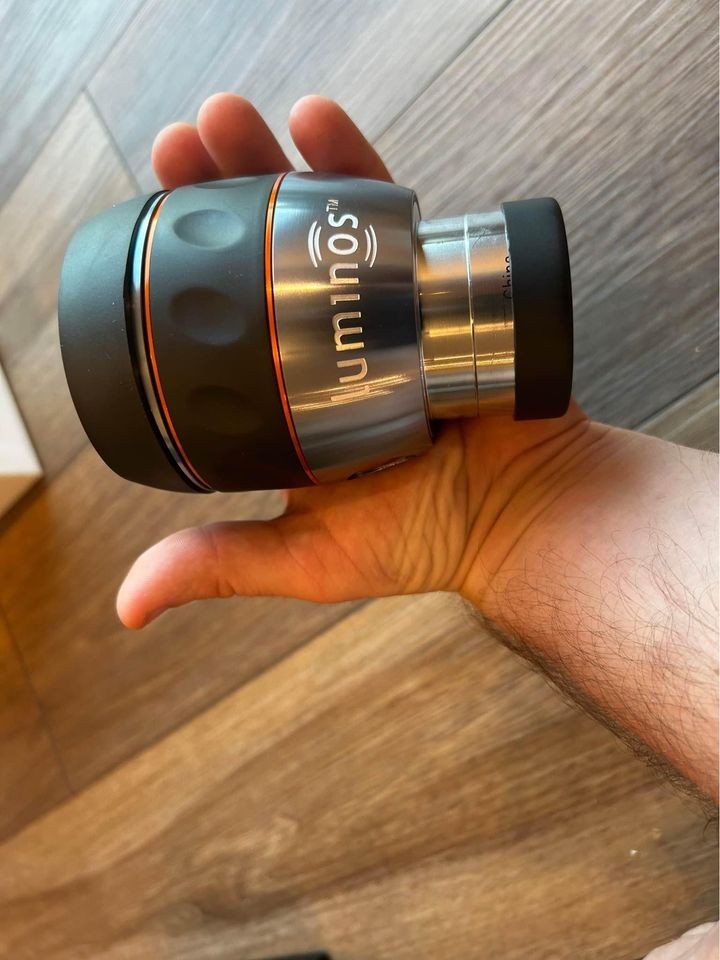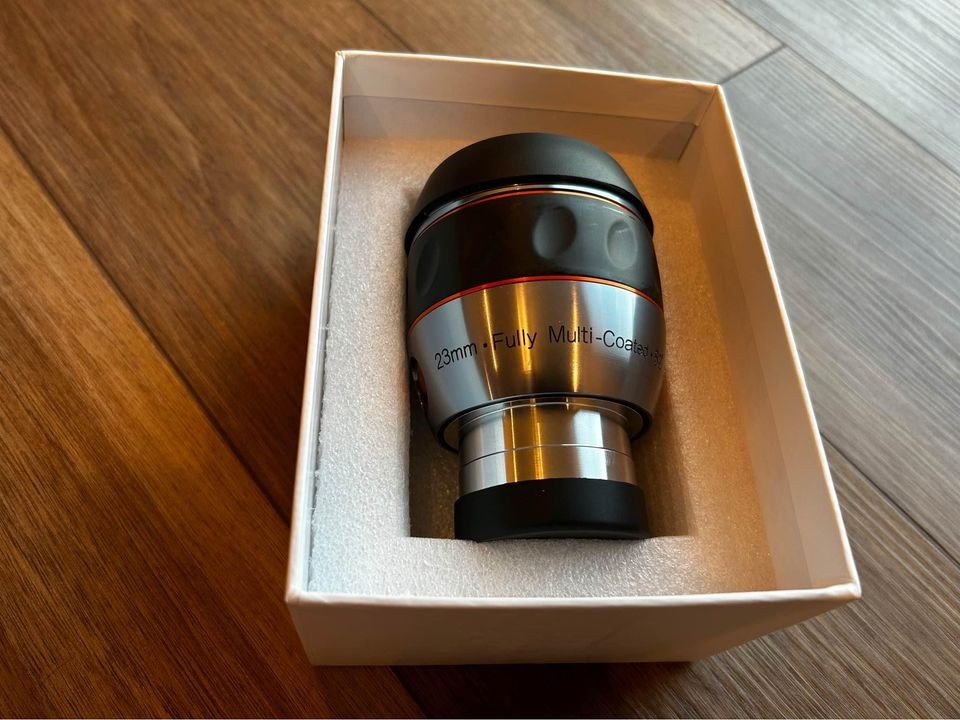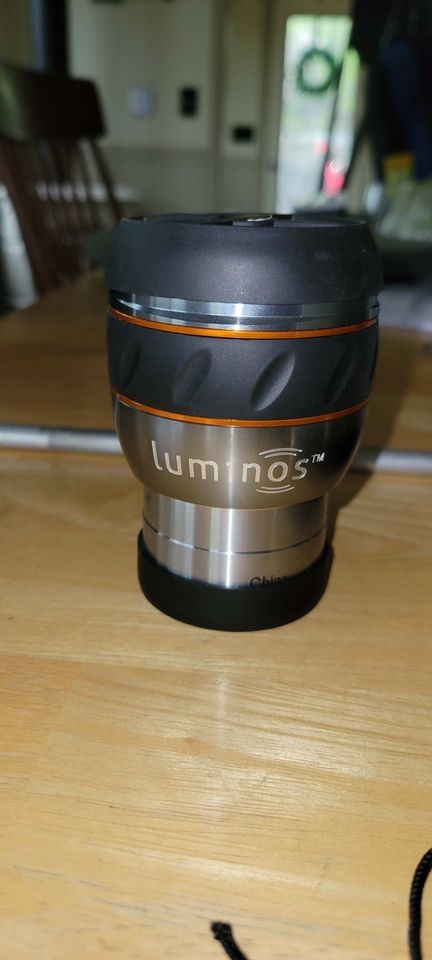
Celestron’s Luminos eyepieces are an ultra-wide-angle eyepiece line that has been around for a while. While facing fierce competition from other UWA eyepieces, the Luminos is a decent pick for an ultra-wide-angle design. The Luminos eyepieces are available in 6 focal lengths: 2” barrel 31mm, 23mm, and 19mm focal lengths, along with 1.25” 15mm, 10mm, and 7mm units.
Celestron also sells a 2.5x, 2” Luminos-branded Barlow lens. This is a good Barlow lens, but we probably wouldn’t recommend it due to the weight and the overall lack of a good reason for purchasing a 2” Barlow.
Which Luminos Eyepiece To Buy?
The 31mm Luminos is heavy and has fairly obvious edge-of-field brightening, but it provides nearly the maximum true field achievable with a 2” eyepiece, making it probably the best pick of the 2” Luminos oculars. We would recommend skipping the 23mm and possibly the 15mm, while the 10mm and 7mm eyepieces have relatively few flaws and the 19mm is acceptable. The 10mm Luminos is easily the best of the lineup and is an excellent medium to high-power eyepiece.
Luminos Eyepieces’ Optical Design & Performance

The Celestron Luminos eyepieces are, more or less, clones of the Tele-Vue Nagler optical design. The apparent field of view, as with the Nagler, is specified at 82 degrees and is more or less such. The principal difference between the Luminos design and most other UWAs is that it features an unusual property known as angular magnification distortion.
For instance, the field stop of the 23mm Luminos has a 37mm diameter, which would give it a 92-degree apparent field. However, the magnification of the eyepiece is lowered as you approach the edges of the field of view – a type of extreme field curvature, in a sense. The result is twofold – the apparent field of view is still 82 degrees, and the edges of the field of view are essentially “compressed” gradually, by up to 26% in the case of the 23mm Luminos. This effect is known as “angular magnification distortion.” However, you’re unlikely to notice the curvature, which is no more than 35% even in the 7mm Luminos, as much as the edge of field brightening.
Because the magnification of the Luminos eyepieces is lower at the edges of the field of view than in the center, the background sky is brighter as a result. This is a huge complaint from many users.
However, you will only notice this if you are observing under moderately light-polluted skies and looking at deep-sky objects at low power with no filter. Sufficiently dark skies will reduce the effect, while severe light pollution will create such a bright background that the subtle brightening is not a sufficient increase to notice. High powers dim the background so much that a subtle increase in brightness does not matter. The edge-of-field brightening is caused by a mix of the actual sky background being brightened combined with internal reflections in the eyepiece, which amplify perceived background sky brightness.
You will not notice edge-of-field brightening at all if you have dark skies or if you have very light-polluted skies or if you are using a Luminos with a telescope that produces a magnification that results in under a ~3mm exit pupil (or around 8x per inch of aperture), or are looking at a bright target, or if you are using a narrowband nebula filter.
The 10mm and 7mm Luminos eyepieces do not match Celestron’s claimed specs and appear to be made by Kunming United Optics, using identical optics to the UWA eyepieces sold by Astro-Tech, Meade, AngelEyes, and others. The 10mm Luminos has basically no angular magnification distortion and thus cannot have edge-of-field brightening.
The chart below shows the parameters of each eyepiece and the specs for angular magnification distortion. The edge-of-field brightness severity is calculated based on the background sky brightness and angular magnification distortion in a given telescope, relative to what the 23mm Luminos would show. The 31mm Luminos has low angular magnification distortion compared to the other eyepieces in the lineup, but its lower magnification makes edge-of-field brightening more obvious.
| Eyepiece | 31mm | 23mm | 19mm | 15mm | 10mm | 7mm |
| True field equivalent to | 87° | 92° | 90° | 99° | 82° | 111° |
| EOFB Severity (23mm baseline) | 0.84 | 1 | 0.525 | 0.74 | 0 | 0.3 |
| AMD Area % | 12% | 26% | 20% | 45% | 0 | 84% |
| AMD Diameter % (Field Curvature) | 6% | 12% | 10% | 20% | 0 | 35% |
| Field Stop | 47mm | 37mm | 30mm | 26mm | 14.3mm | 13.6mm |
| Eye Relief | 27mm | 20mm | 20mm | 17mm | 12mm | 12mm |
| Weight | 40 oz | 17 oz | 16.2 oz | 12 oz | 12 oz | 12 oz |
| Barrel | 2” | 2” | 2” | 1.25” | 1.25” | 1.25” |
These calculations correlate well with observations through all of the Luminos focal lengths tested across telescopes of multiple optical designs and focal ratios. As you can see from the table, despite the 7mm Luminos’ huge angular magnification distortion, the edge-of-field brightening is fairly low, and the 35% field curvature is only mildly perceptible. The 19mm is actually the least-bad offender of all of the Luminos low-power eyepieces, but for some reason it is the target of the most criticism.
All of the Luminos eyepieces perform relatively well at almost any focal ratio, with the only aberrations being field curvature and minor lateral chromatic aberration. However, edge-of-field astigmatism can become visible in telescopes faster than around f/4.5 with all of the Luminos eyepieces, regardless of whether you are using a coma corrector.
Mechanics

The Celestron Luminos eyepieces are surrounded by a wide, metal housing that has a rubber grip ring. Twisting this ring adjusts a twist-up eyecup. This is kind of like the old Meade Series 5000 UWAs, but rather than twisting the whole eyecup, you just turn the ring. It’s a little non-intuitive but the design does work, and the eyecup is extremely comfortable once you’ve set it correctly. However, it does add width and weight.
One important thing to note about the Celestron Luminos eyepieces is that their bulky, heavy bodies and twist-up eyepieces can be removed via a fairly simple process known as “decloaking”. This will require you to jerry rig new eyeguards and top caps, but is a great option if you want to minimize weight or volume and/or wish to use the 1.25” 15mm, 10mm, or 7mm Luminos eyepieces in a binoviewer, which is otherwise not possible due to their width.
Alternative Recommendations
Various other UWA eyepieces are available that you may wish to consider instead of the Luminos lineup.
- The Meade PWA and Astro-Tech UWA eyepieces are much better at their longer focal lengths than the Luminos eyepieces, though the 10mm and 7mm units are identical optically.
- The Baader Morpheus eyepieces have only a 76-degree apparent field but feature extremely sharp, high-contrast views with plenty of eye relief.
- The Explore Scientific 82-degree line features a few very good units and a few so-so focal lengths, some with edge-of-field brightening/AMD and others with too-short eye relief; however most of the set is very good and rivals the Tele-Vue Naglers in performance.
- The Tele-Vue Nagler lineup has decent eye relief, sharpness, few aberrations, and better optical coatings than any of the other UWA eyepieces but the price is of course quite steep.

greetings mr. landers: I hope all is well and happy holidays
just purchased the 150p from skywatcher and having a great deal of fun
I would like to upgrade an eyepiece. your recommendations are welcome
thanks again for your excellent web site. very helpful
kind regards
stephen
If you’re considering a Luminos I’d get the 7mm. Otherwise, a 9mm redline and Barlow lens would probably be my pick.
Excellent article, Zane, with the best explanation of EOFB I’ve ever heard. However, I have noticed EOFB in the Celestron 15mm Edge eyepiece and I only notice it at a dark sky site. In the city, I don’t see it, but in rural settings, it’s evident. But still, what you write about concerning different powers per eyepiece “band” of vision makes sense, and explains well why some parts of the view, particularly the outside “band” can appear bright. Thanks!